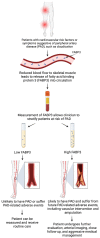The Role of Fatty Acid Binding Protein 3 in Cardiovascular Diseases
- PMID: 36140383
- PMCID: PMC9496114
- DOI: 10.3390/biomedicines10092283
The Role of Fatty Acid Binding Protein 3 in Cardiovascular Diseases
Abstract
Fatty acid binding proteins (FABPs) are proteins found in the cytosol that contribute to disorders related to the cardiovascular system, including atherosclerosis and metabolic syndrome. Functionally, FABPs serve as intracellular lipid chaperones, interacting with hydrophobic ligands and mediating their transportation to sites of lipid metabolism. To date, nine unique members of the FABP family (FABP 1-9) have been identified and classified according to the tissue in which they are most highly expressed. In the literature, FABP3 has been shown to be a promising clinical biomarker for coronary and peripheral artery disease. Given the rising incidence of cardiovascular disease and its associated morbidity/mortality, identifying biomarkers for early diagnosis and treatment is critical. In this review, we highlight key discoveries and recent studies on the role of FABP3 in cardiovascular disorders, with a particular focus on its clinical relevance as a biomarker for peripheral artery disease.
Keywords: FABP3; biomarker; cardiovascular diseases; fatty acid binding protein.
Conflict of interest statement
The authors declare no conflict of interest.
Figures
References
-
- Zemaitis M.R., Boll J.M., Dreyer M.A. StatPearls. StatPearls Publishing; Treasure Island, FL, USA: 2021. Peripheral Arterial Disease. - PubMed
Publication types
LinkOut - more resources
Full Text Sources
Miscellaneous


